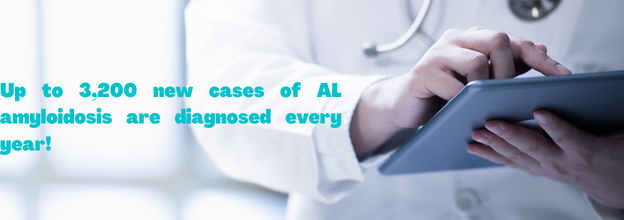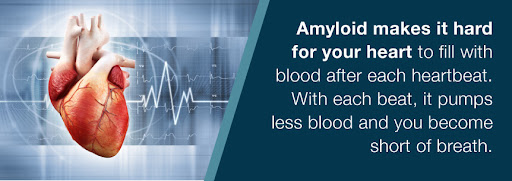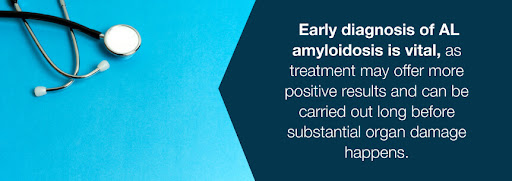You’ve likely heard how medical marijuana provides relief from various symptoms, such as nausea, chronic pain, and inflammation. Now, there’s research suggesting medical marijuana for AL amyloidosis might be helpful for some of its symptoms, too.
Amyloidosis is a rare condition that occurs when too much abnormal protein or amyloid accumulates on the organs. The bone marrow is where amyloid is normally produced. Various types of proteins can become amyloid deposits. However, only a few are associated with significant health problems.
The effects of amyloidosis on different organs is associated with different amyloid types. The condition primarily targets the:
Extremely elevated levels of abnormal protein buildup can cause organ failure.
The amyloidosis type you develop depends on protein type and where it collects. Amyloid deposits can occur in certain areas or throughout the entire body. AL amyloidosis is the most common type. Other less prevalent types include:
The most common form of amyloidosis is light-chain AL amyloidosis. The “A” refers to “amyloid light” chains — a type of associated fibrillar protein. The “L” represents the light chain fragment or immunoglobulin light chain. AL amyloidosis used to be known as primary amyloidosis or primary systemic amyloidosis, but this is no longer the case.
Even though AL amyloidosis is thought of as a rare condition, it has an incidence similar to chronic myelogenous leukemia, or Hodgkin’s lymphoma, reports the Journal of Medical Cases. There’s no known cause why this type occurs, but individuals with the blood cancer known as multiple myeloma associate with it.

Estimates reported by the National Library of Medicine reveal that there are approximately 1,275 to 3,200 new AL amyloidosis diagnoses annually. However, studies involving autopsies suggest it could have a higher incidence rate.
Treatments can help to limit amyloid protein production and manage your symptoms.
While anybody can develop this condition, certain factors could increase your risk, including:
In 1639, an autopsy case was possibly the first explanation of an amyloidosis patient. A doctor and Dutch poet living in Amsterdam, Nicolaes Fonteyn, published the case. In the centuries following, there were other similar described autopsy cases. The term “amyloid” for this hyaline and amorphous tissue change was derived from a starch-type material iodine-staining reaction.
A famous German pathologist, Rudolph Virchow, was first to refer to the word “amyloid” in 1854. In 1922, Bennhold introduced the Congo red stain to identify tissue amyloid deposits. Two Americans, Calkins and Cohen, detected amyloid’s fibrillary nature in 1959 when they used the electron microscope to view the material.
You might not have any symptoms and signs of AL amyloidosis until you reach the advanced stage of the condition. When you do notice symptoms, they will depend on the affected organs or system, such as the liver, kidney, heart, skin, tongue, intestines and nerves. Some symptoms and signs of amyloidosis include:
If you have amyloid deposits in your heart, it can cause your heart muscle walls to stiffen. Your heart muscle may also become weaker, which affects its electrical rhythm. If you have amyloidosis affecting your heart, you could experience:
The kidneys are responsible for filtering toxins and waste from your blood. Amyloid deposits on the kidneys impair their function. If your kidneys can’t do their job properly, fluids and toxins buildup inside your body. With kidney amyloidosis, you may experience:
Gastrointestinal (GI) tract amyloid deposits slow your muscle contractions down, which you need to move food through the intestines. When this happens, it interferes with digestion. You may experience:
If it involves your liver, it can lead to liver enlargement, abnormal liver function tests, and fluid buildup in your body.
Amyloid deposits may damage your peripheral nerves (nerves outside your spinal cord and brain). With amyloidosis affecting your nerves, you may experience:
Amyloidosis may also affect other organs like your skin, lungs and spleen. If you experience any symptoms of amyloidosis persistently, see your doctor.
Potential amyloidosis complications depend on the organs affected by amyloid deposits. Amyloidosis can cause severe damage to your:
Heart: Amyloid makes it hard for your heart to fill with blood after each heartbeat. With each beat, it pumps less blood and you become short of breath. Amyloidosis can disturb your heart rhythm if it affects the electrical system of your heart. If it affects blood pressure nerves, you may feel dizzy or close to fainting when you stand up too quickly.
Kidneys: Amyloid can damage the filtering system of your kidneys and cause the protein to leak into your urine from your blood. It can lower your kidney’s ability to clear your body of waste products, eventually leading to kidney failure.
Nervous System:You could experience numbness, pain or tingling in your fingers and a burning sensation or lack of feeling in the soles of your feet and toes.
Digestion: If amyloid affects your bowel function nerves, you could experience episodes of alternating diarrhea and constipation, which may accompany nausea.

Anxiety and depression symptoms often occur in AL amyloidosis patients and can negatively impact everyday functioning, according to the American Society of Hematology. Patients with cardiac AL amyloidosis have a greater likelihood of experiencing anxiety and depression.
Statistics about the condition, according to the Amyloidosis Foundation, include:
Your doctor will perform a comprehensive exam and take an accurate and detailed account of your medical history to help them diagnose amyloidosis. Your doctor may perform free light chain testing or electrophoresis laboratory techniques to spot any early occurrences of amyloid proteins. While some tests, such as blood and urine tests, can indicate signs of the amyloid protein, only small biopsy samples of organs, tissues or bone marrow can positively confirm an amyloidosis diagnosis.
Diagnostic methods physicians use for AL Amyloidosis include:
Tissue and organ biopsies: They may perform a biopsy to confirm an amyloidosis diagnosis and identify the specific protein type involved in the condition. Physicians take a tissue sample for microscopic analysis. They usually take tissue from the fat surrounding the abdomen or around the rectum. You can have this procedure done on an outpatient basis. However, you may require a hospital stay if your doctor is taking samples from your liver, kidney, nerves, skin or gums. The samples are stained with an amyloid-reacting dye to examine under a microscope.
Blood, urine and imaging tests: Your doctor may also perform urine, blood and imaging tests to check the function of your organs. You may have an ultrasound of the heart, or electrocardiogram, to look for amyloid deposits in your heart.
Bone marrow biopsies: This can help the physician arrive at the percentage of abnormal amyloid-producing plasma cells.
Genetic tests: If they suspect your condition is passed down through your family, genetic testing is required. Hereditary amyloidosis treatment is different from therapeutics and medicines used to treat other types of this condition.

Some tests are performed to diagnose AL amyloidosis while others are used to monitor disease progression and treatment response. Early diagnosis of AL amyloidosis is vital, as treatment may offer more positive results and can be carried out long before substantial organ damage happens.
Treatment is imperative for those who have AL amyloidosis. As it is a progressive condition, if left untreated, it can be fatal. If organ damage has occurred, physicians focus on stabilizing organ function initially. They also treat any underlying conditions — for example, infection, myeloma or inflammation — though AL amyloidosis is not secondary to other disorders.
Treatment for AL Amyloidosis has a two-fold purpose:
Both are designed to prolong survival and enhance quality of life. Physicians provide individualized treatments for AL amyloidosis based on the patient’s medical and health circumstances. Factors that help determine appropriate treatment plans for patients include:
The main treatment methods for AL amyloidosis are:
Many multiple myeloma chemotherapy medicines can treat AL amyloidosis to stop amyloid-producing abnormal cells from growing. Sometimes chemo is not recommended, such as when you have mild or non-progressive amyloidosis or the disease is localized.
Autologous stem cell transplant (ASCT) is another type of treatment for some patients. With this procedure, the doctor collects stem cells from the blood and stores them while you receive high-dose chemo. The stored stem cells are reintroduced to the body intravenously (IV).
The doctor will give you ASCT treatment if your disease isn’t in the advanced stages and the condition greatly affects your heart. Common side effects of ASCT include infections, bone marrow suppression, Interstitial Pneumonia Syndrome (IPS), Sinusoidal Obstructive Syndrome (SOS), Veno-Occlusive Disease of the Liver (VOD) and graft failure.
Commonly, physicians treat AL amyloidosis with chemotherapy followed by ASCT to offer the most promising results. When combined, these treatments aggressively attack abnormal plasma cells within the bone marrow responsible for primary amyloidosis. The use of a high dose of chemotherapy coupled with stem cell transplantation is considered a medical breakthrough in the treatment of primary AL amyloidosis.
Supportive care can help for different symptoms like kidney or cardiac problems. It may also help change your quality of life. With supportive care, your doctor may prescribe a:
The kidneys may be involved in about two-thirds of AL amyloidosis patients. If the patient has severe kidney damage and is deemed healthy enough to handle the procedure, doctors may recommend a kidney transplant.
The heart may be involved in up to three-quarters of patients. Patients may experience low blood pressure, edema (fluid retention), congestive heart failure and arrhythmia. If the heart is severely involved, physicians may recommend a heart transplant.
Proper management of kidney dialysis, heart failure and heart problems can improve your quality of life significantly. Doctors recommended therapeutics to alleviate symptoms, such as the following:
The cannabis plant’s cannabinoids have been used in medicine widely for many years as an:
If another disease causes your condition, your physician may treat it aggressively. If caught in time, this may drastically improve the symptoms a patient experiences, or it may slow the disease from getting any worse. While some patients are okay with taking the more traditional pharmaceutical approach to treating amyloidosis, some patients do not respond very well to those treatments. This is where medical marijuana can serve as an exceptional alternative treatment option to this disease.

Medical marijuana can treat amyloidosis in a great variety of ways, all of which are very beneficial to a patient who is suffering. Marijuana serves as an anti-inflammatory and can provide the reduction of bodily swelling.
Marijuana is also great for alleviating nausea sustained during the patient’s everyday routine. Traditional methods of medicine, mainly involving opiates, can cause tough side effects hard to cope with, ironically enough like nausea. High CBD marijuana has been shown to reduce pain, inflammation, stomach cramps, nausea.
You’ve probably noticed already that medical marijuana seems to help with conditions exhibiting at least one of these characteristics:
People have recognized weed’s anti-inflammatory properties for a long time, but it’s only recently that we’ve come to understand CBD’s role in these characteristics. CBD helps reduce pain, stomach cramps, inflammation and nausea. It also helps reduce anxiety and depression with certain CBD strains.
THC prevents amyloid plaque formation. Medical cannabis for AL amyloidosis may hinder B-amyloid peptide aggregation. Immunomodulatory properties of cannabinoids can help with neuroinflammatory conditions. THC is an analgesic and a neuroprotector. It can subdue cell-mediated immune responses. CBD reduces anxiety, inflammation and nausea.
Effective cannabis strains to consider include:
Inflammation
Nausea
Fatigue
Diarrhea
Anxiety and Depression
As the medical cannabis industry keeps expanding, doctors and patients continue to look for effective ways to use weed as a treatment. The good news for them is that bongs and joints are no longer the only options. Although people still use these traditional delivery systems, they’re now starting to realize the benefits of higher-tech and safer alternatives.
Some marijuana for AL amyloidosis treatment delivery methods include:
There are marijuana and AL amyloidosis therapies to help. If you’ve already researched your state’s laws on medical weed, organized your items to obtain a medical marijuana card from your state and have checked out the regulations and latest news, it’s now time for you to find a local marijuana-certified doctor who can provide you with a recommendation for cannabis so you can start treatment.
MarijuanaDoctors.com is the leading and trusted gateway for connecting patients with medical cannabis doctors. Read through our resources for patients sections, then schedule your appointment today to begin finding relief from your AL amyloidosis condition.
Find A Doctor Find A Dispensary